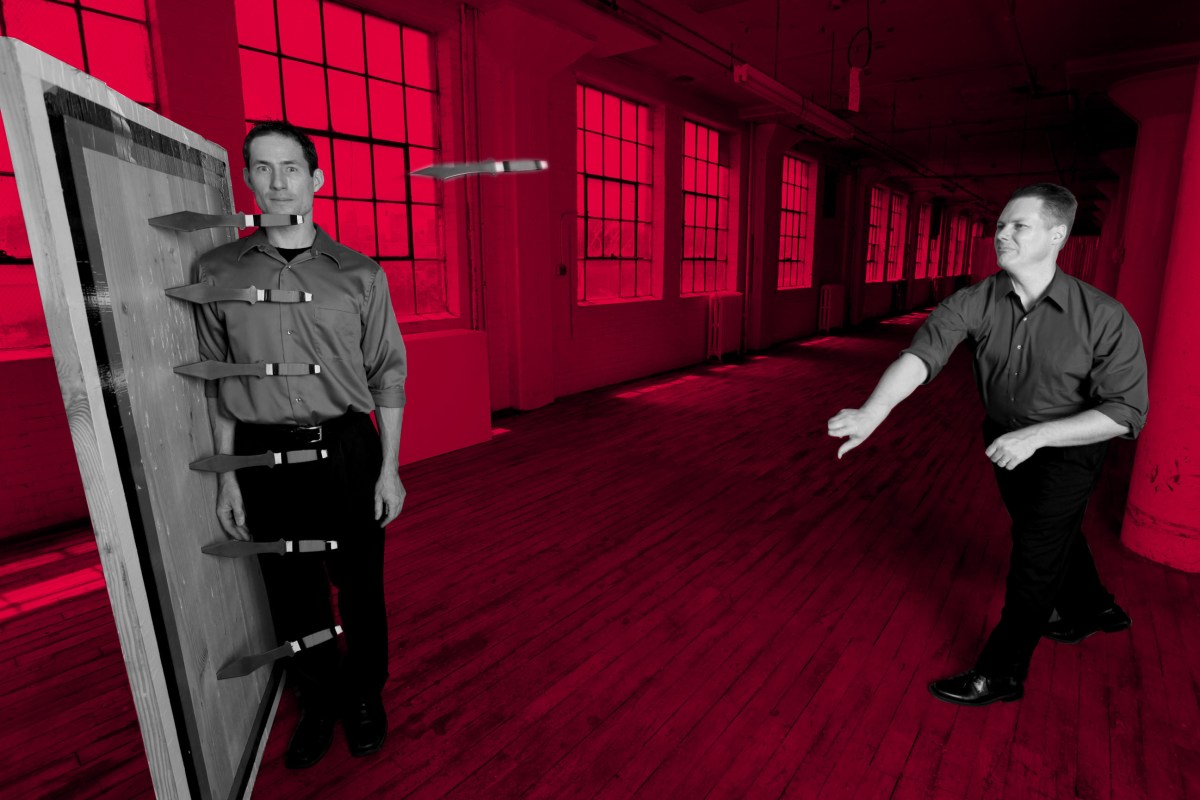What are the most popular skills people are learning during quarantine? Anecdotally, bread baking, cocktail mixing and conscious uncoupling must be near the top. But while many have rightly pointed out that a pandemic isn’t a creative retreat and people shouldn’t feel pressure to emerge from quarantine with the next great American novel in one hand and a Mason jar of sourdough starter in the other, there are certainly better ways to spend your time than rewatching Breaking Bad for the fourth time.
On the other hand, it’s movies that have inspired many people to pick up our favorite underrated quarantine skill: knife-throwing.
“That’s what inspires a lot of people to do it. There are a lot of the old ninja and martial arts movies … You’ll see it in your fantasy movies like The Lord of the Rings,” Caleb McEwen tells InsideHook. “You can get into your artsy films like Girl on the Bridge from France. I know a lot of knife throwers talk about watching that movie.”
Yes, while everyone else is in the kitchen, you should be learning how to throw knives during this time of self-isolation. To help, we dialed up McEwen, who spends most of his time as the artist and creative director of Brave New Workshop, a theater in Minneapolis. But for the purposes of this story, he’s also one of the best knife throwers in the world (though he’s hesitant to accept that label), performing for over a decade in a three-man troupe called The Danger Committee.
How good is McEwen? Without sending you down too deep of a YouTube hole — which includes everything from a turn on American’s Got Talent to annual showcases at renaissance festivals — here’s all you need to know about his accuracy with a knife:
Yeesh. Personally, that calls to mind Gangs of New York more than anything else.
To help you learn how to stick a knife in a stationary board and go from there, we asked McEwen about his beginnings, the building blocks of the skill and the most common misconceptions that non-throwers tend to believe.
How to Get Started
“People are always like, ‘How did you learn to throw knives? What got you into it?’ It’s a boring story,” said McEwen. “It’s not like one day I was being attacked by a coyote and all I had was my trusty knife. I didn’t climb a mountain and find a master to train me. I bought some knives and I spent a lot of time, and I taught myself. That’s about it.”
While it’s not a cinematic story, it’s promising for anyone who wants to learn. The first thing to get straight is what type of knife throwing you want to learn. “I practice traditional knife throwing, or rotational knife throwing, or spin knife throwing, where the knife actually turns in the air,” he explained. Another style that’s been popularized in recent years is calling no-spin throwing, or combat-knife throwing. “It’s kind of a misnomer, because in most cases the knife is actually rotating, it’s just doing it very slowly,” he said.
“What I’ll just say is that, that’s not what I do. I’m a traditional circus-style, rotational knife thrower,” McEwen said. You can read between the lines of that remark; but from a spectator perspective, rotational knife throwing is much more impressive, and from a user perspective, it’s simpler and more accurate.
While McEwen taught himself during the pre-YouTube age through a lot of trial and error, he says the video platform is the best place to start now. There are plenty of good instructional tutorials to learn the basics, but according to McEwen, the most important thing to know is to keep it simple: “We use this line in our show and I make jokes about it a lot; there’s only one knife-throwing trick: pick a point in space, throw a knife, and you either hit it or you don’t. Everything else is just window dressing.”
As for his personal setup at home, despite having significantly more space than most (“I’m lucky enough to have a house with a very large garage, because the guy who owned it before me restored custom cars”), his practice is easily replicable. “I pretty much put little pieces of tape on a board and I throw at them, that’s about it,” said McEwen, adding that a wall with some extra plywood and 2-inch by 12-inch boards as targets is plenty. “Clearly we do some very complicated tricks in the show, but they’re all just variations on throwing and hitting a point in space.”
The Biggest Misconceptions About Knife-Throwing
“Movies, and particularly martial arts movies, have not always given an accurate representation of what knife throwing is,” explained McEwen. “You have a tendency to think of a ninja who’s hiding these tiny little knives in his sleeves and they’re flying like bullets. That’s just not realistic.”
Beyond cinematic fantasies, the ninja element also gives beginners the wrong idea about what kinds of knives are best for throwing. Ninja stars, embellished kunai and concealable spikes may look tantalizing online, but once they show up at your door, they may not be what you expect.
“The type of knife you want to get is a bigger, heavier, stronger knife than what you often see sold as throwing knives on eBay or some of the import sites,” he said. “The truth is that force equals mass times acceleration, and you need mass in the knife in order for it to have enough force to dig into your target that you’re throwing at. If you have a tiny little light knife, most people are not capable of throwing it hard enough in order for it to actually do any kind of real damage or penetration when you’re throwing it at your target.”
He offered a more relatable sports analogy: “If you think about it, you can throw a baseball hard for an entire game and you’re fine. But if you tried to throw a ping-pong ball at 90 miles an hour, after a couple of throws your shoulder is going to feel like it’s going to fall out of its socket, because there’s no resistance there … So the bigger, longer, heavier knife is what most people are looking for.”
I didn’t climb a mountain and find a master to train me. I bought some knives and I spent a lot of time, and I taught myself.
Caleb McEwen of The Danger Committee
What Are the Best Knives to Use?
“I throw a number of different knives,” said McEwen. “All of them are more than 12 inches long … and they’re all about an ounce per inch as far as weight. They range in weight from about 11 ounces with the lightest knives that I throw up to a full pound. That’s important. It helps to control the knife, it allows the knife to bite into the wood. It slows down rotation.”
While he has dabbled in custom knives when working with The Danger Committee, right now, his go-to is a diamond head model, or circus thrower, from Western Stage Props out of Las Vegas.
“The design has been around for a very long time,” he explained. “It has some specific things about it that make it good for rotational throwing and good for throwing in a show. It shows well. It’s a big knife. It’s shiny. It moves a lot of light. It can slice and penetrate well through the point. So if you’re doing tricks that involve that, it’s good.”
The Dos and Don’ts
- “Don’t throw around a person. I know that’s my job and everything and I do. That’s something that came so much later down the line.”
- “You can get hurt doing it, but it’s actually, as a sport, very safe. I always joke that I’ve been with The Danger Committee for 13 years, went through thousands of knives, done all kinds of stunts and whatnot — we’ve never had an instance where one of us has had to go to the hospital or anything like that.”
- “It’s better to spend some money on a few good knives than it is to buy a whole bunch of cheap ones.”
- “It’s repetition, repetition, repetition more than anything else. There are lots of different techniques and you should find the one that works for you and that you’re comfortable with, and you should keep doing it.”
Want to see more from McEwen? While The Danger Committee can’t perform at the moment, McEwen, along with his cohorts Jason LeMay and Mick Lunzer, has been offering free streams of the group’s previous shows on their Facebook page.
He’ll throw a few knives for you and offer some live commentary, just be sure to throw a few dollars his way on their donation page.
Whether you’re looking to get into shape, or just get out of a funk, The Charge has got you covered. Sign up for our new wellness newsletter today.























